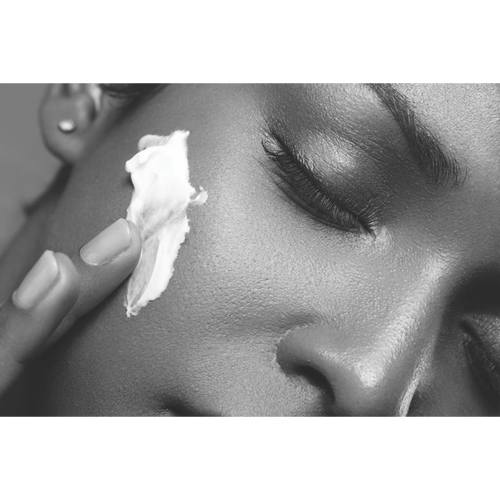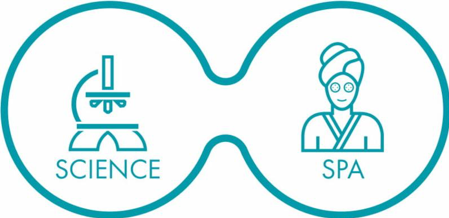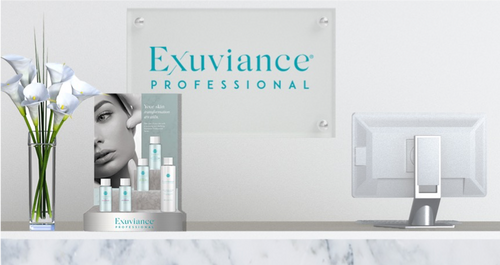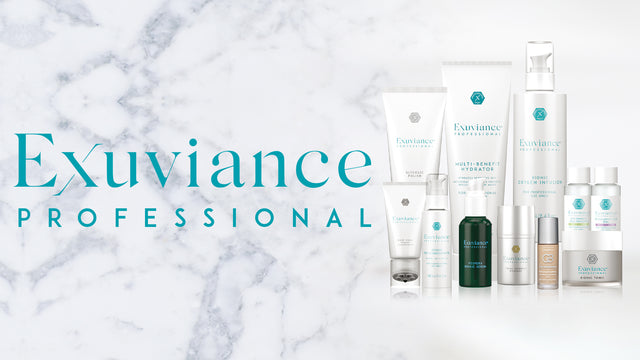
EXUVIANCE®: THE SCIENCE OF SKIN TRANSFORMATION
SHED, REVEAL, TRANSFORM
Exuviance® Professional offers a complete line of skin-transforming products that addresses every concern your patients might have, both in the treatment room and at home.

WHERE SCIENCE MEETS SPA
COMPREHENSIVE, HIGHLY EFFECTIVE SKINCARE
Founded by globally recognised innovators in clinically-developed, effective skincare, who discovered Glycolic Acid and have a deep understanding of skin science at the molecular level, Exuviance® Professional is dermatologist developed and has perfected the science of skin transformation by delivering full-strength anti-ageing benefits without irritation.


EXUVIANCE® PROFESSIONAL PEELS
BESPOKE DEEP PEELS FOR IN-CLINIC TREATMENTS
The Exuviance® Professional Peel System offers the professional practitioner the flexibility and strength options to address your patients’ specific skin types and conditions.
-
Why did you change the packaging? Are the products still the same?
Our science and formulations have not changed – these are the same skincare products you know and love, with a new, refreshed look. We recognised an opportunity to stand for something greater, so we updated our packaging and mission to enable self-care and self-love. We hope you enjoy the new look and feel as much as we do! And rest assured, you’ll still be getting the same formulations and can expect the same great skin-transforming results you always have, just with updated packaging you’re going to love putting front and centre on your shelf.
-
What are Parabens and why are they in your products?
Parabens are ingredients known as preservatives that protect products against the growth of bacteria and fungi they may encounter during use. Our bodies quickly change parabens to the natural para-hydroxybenzoic acid and eliminate them. The individual parabens at the levels used by NeoStrata Company, Inc. are globally acceptable.
-
What is the shelf life of your products? Can I use a product after it has expired?
Products are manufactured to have a 3-year shelf life. Each of our products have a unique lot code. Our Customer Care team can assist with expiration dates based on these lot codes.
Our team can be reached by email at orders@aestheticsource.com or via telephone on 01234 31 31 30. We do not recommend using any products past their substantiated expiration date as we wouldn’t be able to verify their safety and efficacy.
-
How long will it take to see results for products?
Your skin will start to see some surface improvements after just a few weeks of using the products – skin will become softer, smoother, and more radiant. With continued use, after 6 to 8 weeks, your skin will experience longer term skin benefits such as improvements to uneven skin tone, appearance of fine and wrinkles as well as firmness.
-
What is the compatibility of Exuviance® products with other cosmetics and drugs; what is the order of application?
Exuviance® products can be used in conjunction with other cosmetic and therapeutic skin care regimens. In general, we recommend applying products in order of increasing viscosity.
The recommended procedure is: (1) cleanser and toner; (2) high performance treatment products including masks, peels, microdermabrasion; (3) topical medications, if appropriate, allowing time for absorption (a few minutes); (4) concentrates or serums (5) moisturiser and/or sunscreen (6) makeup. Consult your doctor for any specific questions regarding drug compatibility with skincare products.
-
A NOVEL TYROSINE AMINO ACID DERIVATIVE AS A TOPICAL WRINKLE FILLER
Barbara A. Green, RPh, MS, Brenda L. Edison, BA, Irina Brouda, MA, Anthony D. Gonzalez, BS, Uma Santhanam, PhD, Raaj Khusial, PhD, Ronni L. Weinkauf, PhD
INTRODUCTION: Wrinkles result from repetitive motion in combination with damage from free radicals following exposure to sunlight and pollution. These visual signs of ageing can be mitigated with various dermal fillers and botulinum toxins for patients willing to undergo injectable therapies. However, for patients who prefer topical antiwrinkle treatments over injections, a new compound derived from the amino acid tyrosine may provide a topical benefit. In a preliminary investigation, topical use of the new tyrosine derivative increased viable epidermal thickness and built volume in the dermal matrix with the potential for a faster and more potent skin plumping effect than alpha hydroxy acids. Additionally, the new tyrosine derivative was found to have high oxygen radical absorbance capacity (ORAC value = 5149 µmol TE/g), making it a superior antioxidant to Vitamin C (ORAC value = 650) and comparable to CoffeeBerry (ORAC value = 5700). The new tyrosine derivative may provide an alternative treatment for those patients who are reluctant to use injectable therapies and/or are in a maintenance phase. This poster presents a summary of pre-clinical and clinical studies evaluating the safety and the benefits of the novel tyrosine derivative as a topical wrinkle filler.
-
NEW MULTI-MODALITY, HIGH-POTENCY, PHYSICIAN-DISPENSED SKINCARE PRODUCTS FOR INTENSIVE ANTI-AGEING BENEFITS
M. Elizabeth Briden MD, Irina Brouda MA, Brenda L. Edison BA, Barbara A. Green RPh MS
INTRODUCTION: The morphological and visible symptoms of skin ageing are a combined result of natural age progression and cumulative exposure to damaging ultraviolet radiation with accompanying oxidation by free radicals. Effects are evident at all levels of the skin, including the stratum corneum, the epidermis, and the dermis. Each layer of skin is affected differently, with different cell types serving as targets, and different mechanisms of cellular and matrix deterioration prevailing. The myriad of events taking place at all levels of the skin during the processes of natural aging and photoageing cannot be addressed by any single cosmetic ingredient currently known. We have tested a new line of multi-modality, high-potency, physician-dispensed skincare products developed to deliver anti-ageing benefits targeting all skin layers via diverse yet complementary mechanisms of action. The new facial cleanser, day cream, night cream, and eye cream deliver more than 35% of proven benefit ingredients on a daily basis to provide antioxidant protection and to support moisturisation, surface exfoliation, pigmentation evening, and dermal matrix building. Active benefit compounds include a proprietary blend of retinol (a cosmetic retinoid), N-acetyl glucosamine (an amino sugar), alphahydroxy, polyhydroxy, and bionic acids (AHA, PHA, BA), peptide signalling agents, apple stem cell extract, and broad spectrum antioxidants and sunscreens.
-
DERIVATIVES OF SUGAR COMPOUNDS PROVIDE ANTI-AGEING EFFECTS
Barbara A. Green, RPh, M.S., Brenda L. Edison, B.A., Richard H. Wildnauer, Ph.D., Robert H. Hwu, Ph.D.
INTRODUCTION: The alpha-hydroxyacids (AHAs) have developed into a major ingredient technology for anti-aging and adjunctive therapeutic skincare over the past decade. Polyhydroxy acids (PHAs) evolved from AHA technology, offering similar anti-ageing benefits as AHAs, with reduced sensory irritation and discomfort on sensitive skin. Recent trends in skincare have embraced ‘non-acid’ technology, while still demanding the beneficial effects on skin that have been achieved with the use of AHAs. One new approach in the development of novel ingredient technology utilises sugar (saccharide) derivatives and naturally occurring aminosugar derivatives to provide anti-ageing effects to skin. N-acetylglucosamine is one new compound that is being investigated for use in skincare. Clinical study results with this compound reveal significant anti-ageing benefits to skin, including skin plumping and skin smoothing effects. In addition, it is well tolerated on skin. N-acetylglucosamine is a novel, naturally-derived, ‘non-acid’ ingredient with many potential future applications in cosmetic and therapeutic skincare.
-
TOPICAL N-ACETYL GLUCOSAMINE PROVIDES FAST ACNE-REDUCING BENEFITS AND MILDNESS DEMONSTRATING ITS POTENTIAL UTILITY IN ENHANCING CONVENTIONAL RX OR OTC ACNE TREATMENTS
Barbara A. Green R.Ph., M.S., Richard H. Wildnauer Ph.D., Brenda L. Edison B.A.
INTRODUCTION: N-acetylglucosamine (NAG) is a chemically-neutral, amino sugar found in human proteoglycans and glycosaminoglycans (GAGs), including hyaluronic acid. Studies have shown that exogenously supplied NAG can stimulate the synthesis of water-binding GAGs by fibroblasts and keratinocytes, thus providing a basis for its use in anti-ageing skincare. An anti-aging study of NAG revealed valuable cosmetic effects including diminished mottled pigmentation, improved skin clarity, and increased skin firmness and elasticity with a corresponding increase in skin thickness, so-called plumping. Other research has shown that NAG interacts with glycoproteins involved in corneocyte binding and intercellular cohesion, and that topical NAG can reduce skin flakiness, increase dansyl chloride cell turnover rates, and normalise stratum corneum exfoliation. Investigation into the exfoliative effects of NAG prompted a pilot cell turnover study. An abbreviated model was used to stain inner forearm skin with dansyl chloride. NAG (8% cream, native pH 4.9) was compared to glycolic acid (8% cream, pH 3.7) and to an untreated control. NAG significantly reduced mean fluorescence scores compared to untreated (82%, 62% respectively), which was not as effective as the glycolic acid control (92%). NAG enhanced cell turnover rate and desquamation.
-
MALTOBIONIC ACID, A PLANT-DERIVED BIONIC ACID FOR TOPICAL ANTI-AGEING
Barbara A. Green R.Ph., M.S., Brenda L. Edison B.A., Richard H. Wildnauer Ph.D.
INTRODUCTION: Maltobionic acid (4-O-α-D-glucopyranosyl-D-gluconic acid, MW: 358, pKa: 3.8) is a new polyhydroxy bionic acid formed by oxidation of maltose. Maltobionic acid is comprised of one molecule of D-glucose attached via an ether-type linkage to D-gluconic acid (a polyhydroxy acid or PHA). A chemically similar compound to the well-known lactobionic acid, this novel ingredient has the advantage of being plant derived, as well as, gentle and non-irritating. Maltobionic acid is a strong humectant and is also an antioxidant/chelator. Previous work has documented prominent anti-ageing effects for lactobionic acid including skin plumping and smoothing of surface topography with diminished appearance of fine lines and wrinkles. A study was conducted to evaluate the anti-ageing effects of the new polyhydroxy bionic acid, maltobionic acid.
-
MALTOBIONIC ACID, A POWERFUL YET GENTLE SKINCARE INGREDIENT WITH MULTIPLE BENEFITS TO PROTECT SKIN AND REVERSE THE VISIBLE SIGNS OF AGEING
Irina Brouda, MA, Brenda L. Edison, BA, Ronni L. Weinkauf, PhD, Barbara A. Green, RPh, MS
INTRODUCTION: Maltobionic acid is a naturally-derived polyhydroxy bionic acid that was recently discovered to provide topical anti-ageing benefits. Maltobionic acid is a maltose-derived stereoisomer of lactobionic acid, a well characterised anti-ageing ingredient. Previously, maltobionic acid was shown to be non-mutagenic in the Ames II Assay and did not elicit irritation or sensitisation in the MatTek EpiDerm skin model in vitro. Histological studies with maltobionic acid demonstrated increased epidermal thickness and enhanced GAG staining, in conjunction with a more compact stratum corneum. In a clinical study with 28 Caucasian women, 35-58 years of age, maltobionic acid (8%, pH 3.8) cream improved fine lines and wrinkles, elasticity, firmness, texture, dryness, and clarity of facial skin, and increased forearm skin thickness over 12 weeks of use.
-
LACTOBIONIC ACID, A BIONIC ACID ENHANCES SKIN CLARITY AND PROVIDES SKIN PLUMPING AND FIRMING EFFECTS
Barbara A. Green R.Ph., M.S., Brenda L. Edison B.A., Richard H. Wildnauer Ph.D.
INTRODUCTION: Lactobionic acid has numerous beneficial properties due to its polyhydroxy bionic AHA structure and its known antioxidant effects, making it ideal for use in skincare. The compound is an excellent humectant, is nonirritating to skin and provides skin smoothing and moisturising benefits. It is capable of forming a thin hydrofilm, which provides unique aesthetics to a topical formulation. One of two molecules comprising lactobionic acid is gluconic acid. Gluconic acid has been shown to provide significant anti-aging effects when incorporated into formulations as gluconolactone. Galactose, the second molecular constituent of lactobionic acid, is a chemically neutral sugar found in the body that is utilised by skin during glycosaminoglycan and collagen syntheses, and cell migration; studies indicate that it may enhance wound healing. Lactobionic acid is a major constituent of organ preservation fluids for use during transplantation procedures. This is due to lactobionic acid’s ability to chelate iron and suppress oxidative tissue damage during organ storage and tissue reperfusion. In addition to the potent antioxidant benefits of lactobionic acid which may play an important role in helping to prevent ageing-related skin effects, studies in the field of organ preservation have revealed that lactobionate is a cryptic inhibitor of matrix metalloproteinase (MMPs) enzymes. MMP enzymes are responsible for degrading the skin’s extracellular matrix and overall structural integrity causing wrinkles, skin laxity and telangiectasia. Cutaneous anti-ageing effects of lactobionic acid have been previously studied in combination with gluconolactone. The effect of lactobionic acid alone on anti-ageing parameters has not been previously reported.
-
LACTOBIONIC ACID ANTI-AGEING MECHANISMS: ANTIOXIDANT ACTIVITY, MMP INHIBITION, AND REDUCTION OF MELANOGENESIS
rbara A. Green R.Ph., M.S., Brenda L. Edison B.A., Richard H. Wildnauer Ph.D.
INTRODUCTION: Lactobionic acid, 4-O-β-galactopyranosyl-D-gluconic acid is a polyhydroxy bionic acid that was previously reported to provide significant anti-ageing and protective effects to human skin. Lactobionic acid can chelate metal ions such as oxidation-promoting iron, protect ischemic organs from breakdown and oxidative stress during reperfusion, and improve stratum corneum barrier structure and function and prevent inflammation. Skincare products that contain lactobionic acid can improve skin tone, clarity, and texture as well as reduce lines, wrinkles, and pore size, particularly in photo aged skin.
-
ANTI-AGEING EFFECTS AND TOLERABILITY OF HIGH STRENGTH HYDROXY ACIDS IN MALES WITH MODERATE TO SEVERE PHOTOAGING
Zoe Diana Draelos, MD Dermatology Consulting Services, High Point, NC, USA
INTRODUCTION: Male skincare is a rapidly expanding and poorly understood hygiene market. Where once cleansers and moisturisers were formulated for females, males are now expressing interest in products that are suitable for a bearded face to provide anti-ageing effects. The challenge of facial shaving accompanied by different sebum, apocrine, and eccrine sweat production has created unique formulation considerations. The alpha-hydroxyacids (AHAs) provide cosmetic and therapeutic benefits to skin as a result of their ability to modulate the epidermal process of keratinisation and improve the quality of the dermis in photoaged skin. The polyhydroxy acids (PHAs), such as gluconolactone and lactobionic acid, provide anti-aging effects similar to AHAs with additional benefits including increased gentleness and skin tolerability, along with antioxidant effects and enhancement of stratum corneum barrier function.
-
20% ALPHA/POLY HYDROXY ACID CREAM IMPROVES THE SYMPTOMS OF RECALCITRANT HYPERKERATOSIS
Irina Brouda, Brenda L. Edison, Barbara A. Green
INTRODUCTION: Hyperkeratinisation, a thickening of the stratum corneum, is a well-documented symptom of neurosis, kurtosis pillars, ichthyosis, and psoriasis. These disorders are marked by increased corneocyte cohesion, decreased rates of desquamation, low surface lipid content, and poor water retention in the stratum corneum. Individuals suffering from severe disorders of hyperkeratinisation have unusually dry, rough, cracked, flaky, and itchy skin, which can be both uncomfortable and embarrassing. Over-the-counter moisturisers are helpful for mild xerosis but have limited effectiveness in severe dry skin conditions. Alpha hydroxy acids (AHAs), poly hydroxy acids (PHAs), and aldobionic acids (BAs) have a profound effect on stratum corneum barrier function. Select AHAs reduce corneocyte cohesion and promote desquamation and have been shown to significantly improve severe hyperkeratotic conditions, including lamellar ichthyosis, epidermolytic hyperkeratosis, and X-linked ichthyosis. PHAs and BAs are hygroscopic substances that reduce transepidermal water loss and protect against external insults by strengthening the skin barrier. A well formulated product containing AHAs, PHAs, and BAs can normalise epidermal thickness, restore normal stratum corneum barrier function, and promote better water retention. A high-strength, cosmetically elegant skincare cream containing a 20% combination of alpha/poly/bionic hydroxy acids has been developed to address the challenge of problem dry skin conditions. This poster reviews the effects of this high strength AHA/PHA/BA cream on the clinical presentation of common dry skin conditions including winter xerosis and hyperkeratosis of the heels as well as more severe hyperkeratotic conditions such as psoriasis vulgaris and lamellar ichthyosis.
-
POLYHYDROXY ACIDS (PHAS) PROVIDE CONDITIONING EFFECTS TO SKIN WITHOUT INCREASING SENSITIVITY TO UV LIGHT
Barbara A. Green, R.Ph., Richard H. Wildnauer, Ph.D., Brenda L. Edison
INTRODUCTION: The polyhydroxy acids (PHAs) are skincare ingredients that provide additional benefits to skin compared to traditional alpha hydroxyacids (AHAs) such as glycolic acid and lactic acid. Similar to AHAs, PHAs provide exfoliation, skin smoothing and anti-ageing effects. PHAs are also humectants and moisturisers, and most PHAs possess antioxidant properties. In comparison to commonly used AHAs, PHAs do not cause sensory irritation responses that can limit the use of classical AHAs. Moreover, PHAs are compatible with clinically sensitive skin including rosacea and atopic dermatitis, and corrective cosmetics containing PHAs can be used to conceal skin colour irregularities on sensitive skin, e.g. post-laser purpura, and haemangiomas as in Sturge-Weber Syndrome. PHAs have also been shown to enhance stratum corneum barrier function, increasing the skin’s resistance to chemical challenge. New study results indicate that use of PHAs does not result in an increase in sunburn cells in skin following UVB exposure. Therefore, PHAs are an important alternative to AHAs for individuals not able to use sunscreen protection with their AHAs on a daily basis. In addition, PHAs are shown to be compatible with tretinoin use. Combination use of PHAs plus tretinoin may be preferable to glycolic acid plus tretinoin in view of the potential increase in sun sensitivity by tretinoin.
-
A NEW HIGH-POTENCY, MULTI-MECHANISM SKINCARE REGIMEN FOR PHOTODAMAGED SKIN: RESULTS FROM A VEHICLE-CONTROLLED CLINICAL TRIAL
Barbara A. Green RPh MS, Irina Brouda MA, Brenda L. Edison BA, Ronni L. Weinkauf PhD, Patricia Farris MD
INTRODUCTION: Skin aging is a multi-faceted biological process that cannot be addressed by any single skincare ingredient. A high-potency skincare regimen that delivers over 35% active benefit ingredients was developed to deliver anti-aging effects across all skin layers via multiple mechanisms. The skincare regimen was evaluated in a randomised, double-blind, vehicle-controlled clinical trial and found to be well-tolerated, liked by users, and demonstrated greater anti-ageing effects than a cosmetic vehicle regimen in Caucasian women. The regimen was also shown to be beneficial in reducing pigmentation and other signs of ageing in Asian skin in a separate analysis published elsewhere. This poster presents additional statistical comparisons between the Active and Vehicle groups for clinical grading, pinch recoil measurements, and dermal density changes via ultrasound from the controlled clinical trial.
-
A NEW CLINICAL-STRENGTH, MULTI-MECHANISM SKINCARE REGIMEN DELIVERS SIGNIFICANT ANTI-AGEING BENEFITS IN ASIAN WOMEN
Lisa Buckley, BA; Brenda L. Edison, BA; Ronni L. Weinkauf, PhD; Barbara Green, RPh, MS
INTRODUCTION: The cosmetic concerns of Asian women differ from those of Caucasian women because the primary bothersome signs of skin ageing are pigmentation irregularities in Asian skin compared with lines and wrinkles in Caucasian skin. A new clinical-strength skincare regimen was developed to deliver over 35% active benefit ingredients daily, targeting multiple mechanisms and symptoms of ageing, for use on all skin types. Significant anti-ageing effects of this regimen were previously demonstrated in a Caucasian population. This poster presents clinical study results demonstrating tolerability and effectiveness of this high-strength regimen in Asian women.
-
COMBINING GLYCOLIC ACID PEELS AND EFFECTIVE HOME CARE WITH MICRODERMABRASION OPTIMISES TREATMENT RESULTS
Colleen Johnson BS, LE, Brenda Edison BA, Barbara Green RPh, MS
INTRODUCTION: Microdermabrasion and glycolic acid peels are common aesthetic procedures performed regularly in the physician’s office. Microdermabrasion provides the benefits of exfoliation and stimulation of cellular renewal, and is often used in-office on patients with photodamage and/or acne. Like microdermabrasion, glycolic acid peels exfoliate and stimulate cell renewal in the epidermis which is useful in the treatment of acne to help smooth rough skin. Additionally, glycolic acid peels stimulate dermal biosynthesis to provide anti-aging effects on skin. When combined with microdermabrasion, glycolic acid peels plus the right supportive home care products provide effective benefits to skin without the downtime of more invasive cosmetic procedures.
-
AHA HOME PEELS OFFER BENEFITS TO COMPLEMENT IN-OFFICE PROCEDURES AND OPTIMISE PATIENT SATISFACTION
Brenda L. Edison BA, Colleen Johnson BS, LE, Barbara A. Green RPh, MS
INTRODUCTION: Physician-dispensed home peels are used under the direction of a physician. These formulations can provide significant anti-ageing and skin smoothing benefits that may be used to complement and enhance in-office cosmetic procedures such as stronger in-office glycolic acid peels, microdermabrasion and nonablative laser. They can also be used to introduce a new patient to procedures and/or to maintain benefits after completing office procedures. To maximise skin treatment, home peels should be used in conjunction with supportive anti-aging home care products.
-
A NEW HIGH-POTENCY, MULTI-MECHANISM SKINCARE REGIMEN FOR PHOTODAMAGED SKIN: RESULTS FROM A VEHICLE-CONTROLLED CLINICAL TRIAL
Barbara A. Green RPh MS, Irina Brouda MA, Brenda L. Edison BA, Ronni L. Weinkauf PhD, Patricia K. Farris MD
INTRODUCTION: Skin ageing is a multi-faceted biological process that cannot be fully addressed by any single skincare ingredient. A high-potency skincare regimen that delivers over 35% active benefit ingredients daily was developed to provide anti-ageing benefits across all skin layers via multiple mechanisms. Tolerability and effectiveness of the regimen were evaluated in a randomised, double-blind, vehicle-controlled clinical trial.







